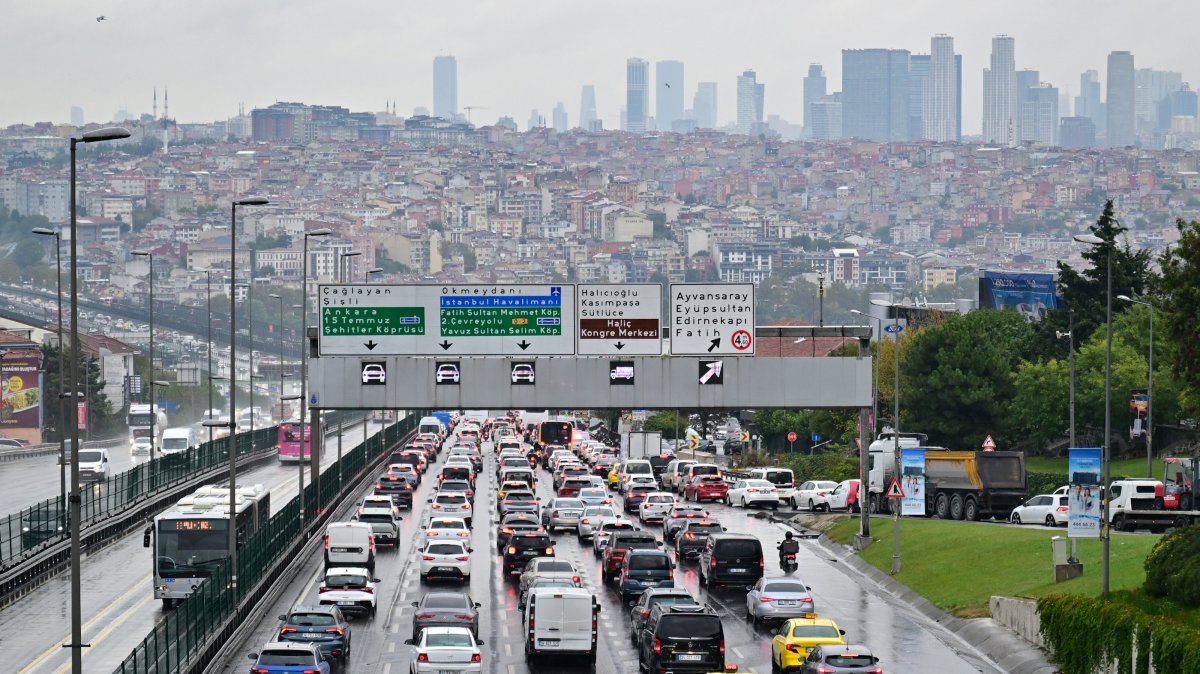Experts say micromobility eases Istanbul’s traffic congestion | Daily Sabah – Daily Sabah

Report on Micromobility as a Sustainable Urban Transport Solution for Istanbul
1.0 Introduction: Addressing Urban Congestion through the Lens of Sustainable Development Goals
Istanbul’s escalating traffic congestion poses a significant threat to urban sustainability, directly impeding progress toward several key Sustainable Development Goals (SDGs). The current transportation crisis affects residents’ quality of life, economic productivity, and environmental health. This report analyzes the potential of micromobility vehicles, such as bicycles and scooters, to create a more sustainable, efficient, and inclusive urban transport system in line with global development targets.
2.0 The State of Urban Mobility in Istanbul
The city’s transport network is under severe strain, a condition described by experts as one of Istanbul’s “bleeding wounds.” This situation creates direct challenges to achieving specific SDG targets.
- Economic and Social Costs: The average resident loses approximately 105 hours annually to traffic delays, undermining productivity and well-being, which conflicts with the principles of SDG 11 (Sustainable Cities and Communities).
- Projected Demand: According to the Istanbul Metropolitan Municipality’s (IBB) Sustainable Urban Transportation Plan, daily trips are projected to increase from 30.3 million in 2020 to 38.1 million by 2040. Managing this growth sustainably is critical for urban resilience.
- Current Modal Split: An analysis of non-pedestrian trips reveals a heavy reliance on inefficient private transport, which is a major barrier to sustainable development.
- Private Cars: 36%
- Public Transport: 23%
- Service Vehicles: 8%
- Micromobility Vehicles: 1%
- Inefficient Road Use: The dominance of private cars, often with single occupancy, contributes disproportionately to congestion and emissions, working against SDG 13 (Climate Action) and SDG 11.2 (access to sustainable transport systems).
3.0 Micromobility as a Catalyst for Sustainable Development
Expanding the use of micromobility offers a strategic pathway to advance multiple SDGs by transforming Istanbul’s transport landscape.
- SDG 11: Sustainable Cities and Communities: Micromobility provides an affordable and accessible transport option, particularly for short trips (under 3 kilometers) and for completing the “last mile” of a journey when integrated with public transit. This enhances access to services and opportunities for all residents.
- SDG 13: Climate Action: Shifting from private cars to electric scooters and bicycles significantly reduces greenhouse gas emissions and the city’s carbon footprint.
- SDG 3: Good Health and Well-being: Promoting active transport like cycling improves public health. Furthermore, reducing traffic congestion lowers air and noise pollution, creating healthier urban environments.
- SDG 9: Industry, Innovation, and Infrastructure: Investing in dedicated micromobility infrastructure, such as protected bike lanes, represents a direct investment in resilient and sustainable infrastructure.
4.0 Challenges to Integration and Road Safety
Realizing the full potential of micromobility requires addressing significant barriers related to infrastructure, safety, and public awareness. These challenges directly impact targets within SDG 3.6 (halve road traffic deaths and injuries) and SDG 11.2 (provide safe and sustainable transport systems).
- Infrastructure Deficiencies: Istanbul currently has only 209 kilometers of dedicated bike paths, forcing users into mixed traffic and creating hazardous conditions. This lack of safe infrastructure, a core component of SDG 9, is the primary barrier to wider adoption.
- Regulatory and Educational Gaps: While regulations prohibit scooter use by individuals under 16, many eligible users lack formal traffic education. This, combined with poor driver behavior toward vulnerable road users, elevates safety risks. In 2024, nearly 7,000 traffic-related fatalities and 350,000 injuries were recorded, highlighting the urgency of improving road safety for all.
- Safety Equipment and User Behavior: Over 90% of scooter accidents involve riders falling. The lack of consistent use of protective gear, such as helmets and wrist guards, increases the severity of injuries.
5.0 Recommendations for a Sustainable Mobility Framework
To effectively integrate micromobility into Istanbul’s transport system, a multi-stakeholder approach focused on the SDGs is essential. The following actions are recommended:
- Develop Resilient Infrastructure (SDG 9 & SDG 11): Prioritize the rapid expansion of a city-wide network of protected and dedicated lanes for micromobility vehicles to ensure user safety and encourage adoption.
- Strengthen Policy and Public Awareness (SDG 3 & SDG 11): Implement comprehensive public awareness campaigns on road sharing, traffic rules, and the importance of safety equipment. Enhance traffic education for all road users, including scooter riders and vehicle drivers.
- Promote System Integration (SDG 11): Foster seamless integration between micromobility services and the public transportation network to provide efficient and sustainable door-to-door travel options.
- Enhance Regulation and Enforcement: Update and enforce regulations to ensure the safe operation of micromobility vehicles while holding all road users accountable for rule violations.
By adopting these measures, Istanbul can mitigate its traffic crisis and transition toward a safer, healthier, and more sustainable urban future in alignment with the Sustainable Development Goals.
Analysis of Sustainable Development Goals in the Article
1. Which SDGs are addressed or connected to the issues highlighted in the article?
- SDG 3: Good Health and Well-being: The article discusses traffic safety, highlighting the number of deaths and injuries from accidents. It specifically addresses the safety risks for micromobility users, such as scooter riders, and calls for protective measures like helmets and improved infrastructure to prevent injuries.
- SDG 9: Industry, Innovation, and Infrastructure: The article focuses on the need for sustainable and resilient urban infrastructure. It points out the inadequacy of current road infrastructure for micromobility, citing the limited kilometers of dedicated bike paths and the dangers this creates. The call to build dedicated lanes and redesign the transport system relates directly to developing quality infrastructure.
- SDG 11: Sustainable Cities and Communities: This is the central SDG addressed. The article revolves around making Istanbul’s urban transport system more sustainable. It examines issues of traffic congestion, the promotion of public transport, and the integration of micromobility (bicycles, scooters) as an alternative to private cars to improve urban mobility and reduce time lost in traffic.
2. What specific targets under those SDGs can be identified based on the article’s content?
- Target 3.6: Halve the number of global deaths and injuries from road traffic accidents. The article directly addresses this by quoting statistics on traffic fatalities and injuries in 2024 (“nearly 7,000 people died and 350,000 were injured”). It also discusses the specific risks and causes of accidents for micromobility users and the need for regulations and safety education.
- Target 9.1: Develop quality, reliable, sustainable and resilient infrastructure… to support economic development and human well-being. The article identifies a critical gap in Istanbul’s infrastructure, stating that the city has only “209 kilometers of dedicated bike paths and 89 kilometers of shared-use roads.” It argues that expanding this infrastructure is essential for the safe and effective use of micromobility vehicles.
- Target 11.2: By 2030, provide access to safe, affordable, accessible and sustainable transport systems for all, improving road safety, notably by expanding public transport. The article’s core theme is the need to shift from private cars to more sustainable options. It provides data on the current transport mix (“23% by public transport… 18% by private cars… 1% by micromobility vehicles”) and advocates for expanding public transport and micromobility to ease congestion and improve overall mobility for residents.
3. Are there any indicators mentioned or implied in the article that can be used to measure progress towards the identified targets?
-
For Target 3.6: The article provides a direct indicator of road traffic safety.
- Indicator: Number of deaths and injuries from traffic accidents. The text states, “In 2024, nearly 7,000 people died and 350,000 were injured in traffic accidents.” This data can be used to track progress on reducing traffic-related casualties.
-
For Target 9.1: The article provides a quantitative measure of the existing infrastructure for sustainable transport.
- Indicator: Length of dedicated infrastructure for micromobility. The text specifies, “Istanbul has 209 kilometers of dedicated bike paths and 89 kilometers of shared-use roads.” This serves as a baseline to measure future development of sustainable transport infrastructure.
-
For Target 11.2: The article implies indicators related to the modal share of different transport systems.
- Indicator: Proportion of daily trips by different modes of transport. The article provides a breakdown: “50% of trips in Istanbul are on foot, 23% by public transport, 18% by private cars, 8% by service vehicles and only 1% by micromobility vehicles.” This data measures the current reliance on various transport options and can be used to track a shift towards more sustainable modes.
- Indicator: Number of micromobility users. The article states, “About 350,000 people in Istanbul use micromobility daily,” with an estimate that “1 million residents rely on micromobility.” This measures the adoption rate of sustainable transport alternatives.
SDGs, Targets and Indicators Table
| SDGs | Targets | Indicators |
|---|---|---|
| SDG 3: Good Health and Well-being | Target 3.6: Halve the number of global deaths and injuries from road traffic accidents. |
|
| SDG 9: Industry, Innovation, and Infrastructure | Target 9.1: Develop quality, reliable, sustainable and resilient infrastructure. |
|
| SDG 11: Sustainable Cities and Communities | Target 11.2: Provide access to safe, affordable, accessible and sustainable transport systems for all. |
|
Source: dailysabah.com
What is Your Reaction?
 Like
0
Like
0
 Dislike
0
Dislike
0
 Love
0
Love
0
 Funny
0
Funny
0
 Angry
0
Angry
0
 Sad
0
Sad
0
 Wow
0
Wow
0
















































:focal(1500,1000)/https://media.globalcitizen.org/a6/9a/a69a4720-d8a1-4715-b596-18738d03c05c/rotary_polio_hero_image.jpg?#)







/countries/sri-lanka/photo-credit---dmc-sri-lanka.tmb-1200v.jpg?sfvrsn=dc298bcc_1#)
















